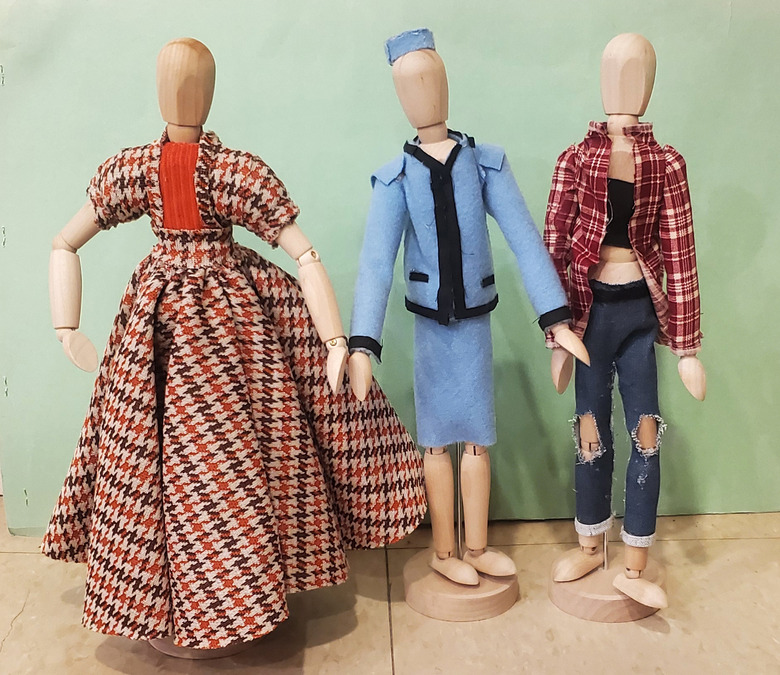- Author:
- Megan Wakefield
- Subject:
- Family and Consumer Sciences Education
- Material Type:
- Activity/Lab, Lesson Plan
- Level:
- Middle School, High School
- Tags:
- License:
- Creative Commons Attribution Non-Commercial Share Alike
- Language:
- English
- Media Formats:
- Text/HTML
Fashion History Doll Presentation Rubric
Fashion History Doll Project

Overview
This lesson is a way students can demonstrate their understanding of fashion history. Students will create an outfit from an assigned/chosen decade to be placed on a doll, that will then be photographed and used to create a video documenting how their doll fits into that decade.
Thumbnail Picture: Fashion History Dolls © 2022 by Megan Wakefield is licensed under CC BY-SA 4.0
Summary
This 3-4 day lesson is a way students can demonstrate their understanding of fashion history. Students will create an outfit from an assigned/chosen decade to be placed on a doll, that will then be photographed and used to create a video documenting how their doll fits into that decade. This lesson is formated for face-to-face instruction but could easily be adapted to other formats.
Background for Teachers
To teach this lesson, you will need an understanding of quintessential looks of each decade in fashion. It would be helpful to use the Utah Fashion Design Studio Standard 3 for reference.
You will need to be familiar with Adobe Spark Video (or similar tool), have an understanding of how to search for images that meet copyright laws, as well as have a way to capture pictures and upload to edit and use in the final project.
A few resources that may be helpful:
- Utah Fashion Design Studio Strands & Standards
- Nearpod Common Sense Education Copyright Lesson
- The Met Art Collection - Public Domain pictures, including historical fashion pieces
- Camera Angles
- How to use Adobe Spark Video
Step 1 - Goals and Outcomes
Learning Intentions:
- Students will be able to identify quintessential looks from a decade in fashion history.
Success Criteria:
- Students will create a look that will incorporate the quintessential look of their decade.
- Students will prepare a presentation on a historical era using pictures from the design they created. (FDS Performance Skill)
- Students will be able to describe how they created the silhouette and design that fits within their decade.
Step 2 - Planning Instruction
Student Background Knowledge
Prior to this lesson, students will need to have an understanding of the fashion historical era and the quintessential looks of that time (Strand 3 from the Utah Fashion Design Studio Strands and Standards). They also will need to know how to use Adobe Spark Video, searching for images that can be used without violating copyright laws, and using digital cameras to capture various angles that can highlight their designs.
*See resources attached to Section 2 of this lesson plan.
Strategies for Diverse Learners
The lesson can be adjusted to meet individual students' needs by reducing or increasing the requirements of the assignment. Such as only requiring using found pictures instead of creating their own design. Students can also use different tools when taking pictures and creating a video. This can also be done individually or in partnerships that could support students who need the additional help.
Step 3 - Instruction
Day 1: Research & Plan:
- Introduce students to project. This can be completed individually or with one other person. They will pick a decade to base their designs and presentation on. This can be assigned or students can sign up.
- They will begin by gathering pictures to use as inspiration for their design. They also can choose to use the pictures they gather as part of their presentation. This might be a good time to review copyright laws and how to search and credit pictures appropriately. A good resource for students to find public domain pictures of clothing from various decades is The Met's Art Collection.
- Students can plan and sketch what look they want to create.
Day 2-3: Create Vision:
- Materials needed for the day: various types of fabrics scraps and trims, needle and thread, hot glue guns, dolls (possible options: Ikea Wooden dolls, used barbie dolls, or dollar tree dolls)
- After researching and creating a plan, students will create their look on their doll. They will put the fabric together using hot glue and/or needle and thread.
Day 3: Fashion Photographer:
- As a class, discuss various fashion careers, This could include ones that they would have already encountered in previous lessons: fashion designer, museum curator, etc. Then discuss that they will be exploring more into fashion marketing/advertising and fashion photography. Explain different ways that photographers highlight looks by using various camera angles.
- After students have completed their design, they will take pictures of their completed design. They should try at least 3 different angles and take at least 6 different photos highlighting different parts of their look including the quintessential look from that decade (they could also highlight principles and elements they used, if covered in class).
Day 4: Video Presentation:
- Students will put together an Adobe Spark Video using their research photos as well as their doll photos. They will add text and voice explaining about their look and how it fits into the historical era.
- To provide choice you could allow students to use other tools to put together their presentation such as Canva Video, Adobe Rush, etc. or they could print out pictures and add labels to create a poster.
Step 4 - Assessments
Students will create an Adobe Spark Video that includes their historical research photos, draped doll photos with voiceover explanations of how they utilized the key features of that decade and music. They will be graded using the Fashion History Doll Presentation Rubric.
* See attached Rubric and Adobe Spark Video Example.